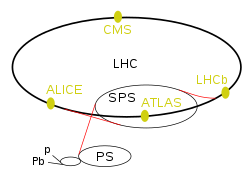 Plan of the LHC experiments and the preaccelerators. | |
| LHC experiments | |
|---|---|
| ATLAS | A Toroidal LHC Apparatus |
| CMS | Compact Muon Solenoid |
| LHCb | LHC-beauty |
| ALICE | A Large Ion Collider Experiment |
| TOTEM | Total Cross Section, Elastic Scattering and Diffraction Dissociation |
| LHCf | LHC-forward |
| MoEDAL | Monopole and Exotics Detector At the LHC |
| FASER | ForwArd Search ExpeRiment |
| SND | Scattering and Neutrino Detector |
| LHC preaccelerators | |
| p and Pb | Linear accelerators for protons (Linac 4) and lead (Linac 3) |
| (not marked) | Proton Synchrotron Booster |
| PS | Proton Synchrotron |
| SPS | Super Proton Synchrotron |
46°14′8″N 6°3′19″E / 46.23556°N 6.05528°E ATLAS[1][2][3] is the largest general-purpose particle detector experiment at the Large Hadron Collider (LHC), a particle accelerator at CERN (the European Organization for Nuclear Research) in Switzerland.[4] The experiment is designed to take advantage of the unprecedented energy available at the LHC and observe phenomena that involve highly massive particles which were not observable using earlier lower-energy accelerators. ATLAS was one of the two LHC experiments involved in the discovery of the Higgs boson in July 2012.[5][6] It was also designed to search for evidence of theories of particle physics beyond the Standard Model.
The experiment is a collaboration involving 6,003 members, out of which 3,822 are physicists (last update: June 26, 2022) from 257 institutions in 42 countries.[1][7]
- ^ a b "ATLAS Fact Sheets". ATLAS. Retrieved 27 January 2022.
- ^ Aad, G.; et al. (ATLAS Collaboration) (2008). "The ATLAS Experiment at the CERN Large Hadron Collider". Journal of Instrumentation. 3 (8): S08003. Bibcode:2008JInst...3S8003A. doi:10.1088/1748-0221/3/08/S08003. hdl:2027.42/64167. S2CID 250683252.
- ^ "Overall detector concept". ATLAS Technical Proposal. CERN. 1994.
- ^ "ATLAS Experiment". CERN. Retrieved 24 October 2019.
- ^ "CERN experiments observe particle consistent with long-sought Higgs boson". CERN. 4 July 2012. Retrieved 2016-11-23.
- ^ "CERN and the Higgs boson". CERN. Archived from the original on 23 November 2016. Retrieved 23 November 2016.
- ^ "The Collaboration". ATLAS. Retrieved 27 January 2022.